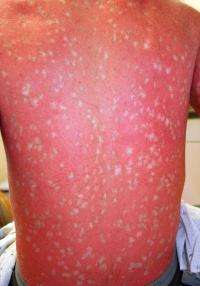Team finds a genetic rarity: A mutation that restores health

Errors in the copying of genes during cell division can cause numerous diseases, including cancer. Yale School of Medicine scientists, however, have unraveled the secrets of a much more rare phenomenon with potential therapeutic implications - disease-causing genes that show a high frequency of self-repair.
In the August 26 issue of Science Express, the Yale team describes how one mutated copy of a gene called keratin 10 causes a severe skin disease known as ichthyosis with confetti. However, amidst the diseased skin, these patients also have hundreds to thousands of spots of normal skin.
This phenomenon, the researchers report, occurs by the recombination of chromosomes prior to cell division. Instead of producing one normal copy of the gene and one dominant, disease-causing mutation, the exchange between chromosomes results in cells with either two mutant copies or no mutant copies. If the latter occurs, spots of normal, disease-free skin will form. The investigators used these recombination events in spots of normal skin to map and ultimately identify the disease gene.
"Usually, you have a disease-causing mutation, and you are stuck with it," said Keith Choate, assistant professor of dermatology and first author of the paper. "But we demonstrate that in this disease, there is an unusually high frequency of the appearance of mutation-free clones of cells." The reason these particular mutations revert to normal so frequently is not clear, note the scientists.
However, in all affected patients the normal tail end of the keratin 10 protein is replaced by a protein sequence enriched for one amino acid, arginine. This causes the mutant keratin 10 to end up in the wrong part of the cell. "We believe the mis-localization of keratin 10 contributes both to the severity of the disease and the appearance of the clones of normal skin," said Richard Lifton, senior author of the paper and Sterling Professor and chair of the department of genetics.
The researchers say that knowing that these particular mutations can revert with high frequency gives them hope that they might find a way to mimic this process to develop treatments for other genetic diseases.
"Perhaps rather than directly correcting disease-causing mutations we might be able to recombine them away, similar to what happens in this disease," said Leonard Milstone, emeritus professor of dermatology and member of the research team.














